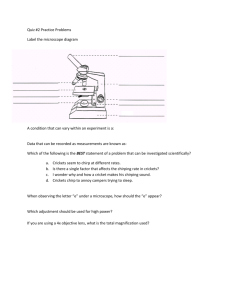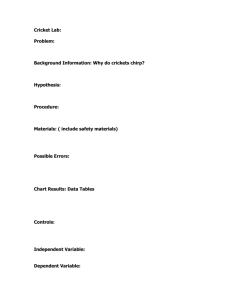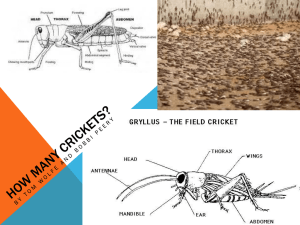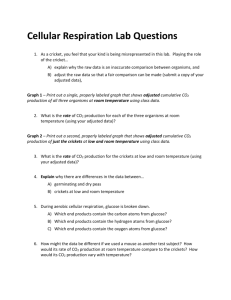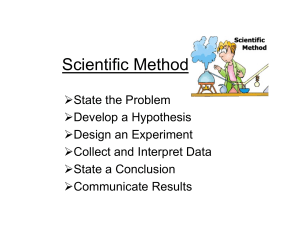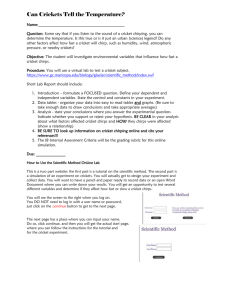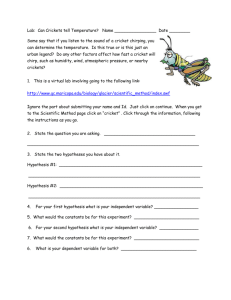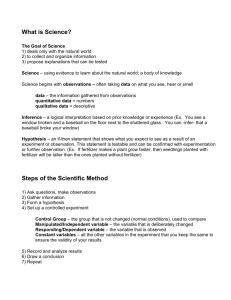Cricket Respiration
advertisement
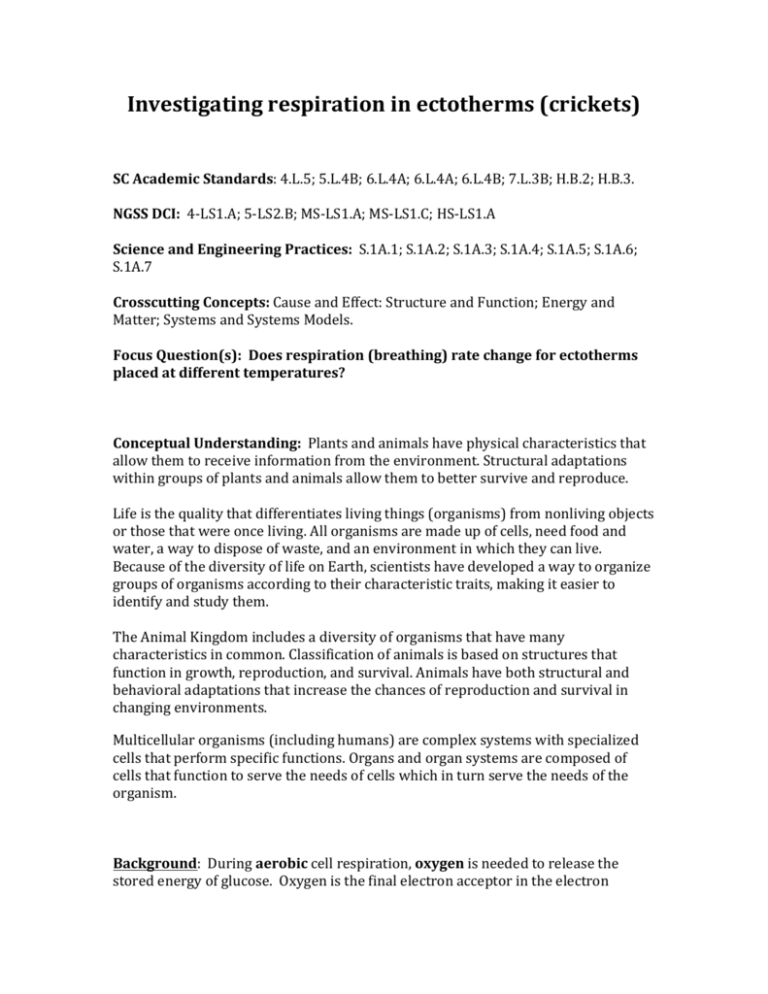
Investigating respiration in ectotherms (crickets) SC Academic Standards: 4.L.5; 5.L.4B; 6.L.4A; 6.L.4A; 6.L.4B; 7.L.3B; H.B.2; H.B.3. NGSS DCI: 4-­‐LS1.A; 5-­‐LS2.B; MS-­‐LS1.A; MS-­‐LS1.C; HS-­‐LS1.A Science and Engineering Practices: S.1A.1; S.1A.2; S.1A.3; S.1A.4; S.1A.5; S.1A.6; S.1A.7 Crosscutting Concepts: Cause and Effect: Structure and Function; Energy and Matter; Systems and Systems Models. Focus Question(s): Does respiration (breathing) rate change for ectotherms placed at different temperatures? Conceptual Understanding: Plants and animals have physical characteristics that allow them to receive information from the environment. Structural adaptations within groups of plants and animals allow them to better survive and reproduce. Life is the quality that differentiates living things (organisms) from nonliving objects or those that were once living. All organisms are made up of cells, need food and water, a way to dispose of waste, and an environment in which they can live. Because of the diversity of life on Earth, scientists have developed a way to organize groups of organisms according to their characteristic traits, making it easier to identify and study them. The Animal Kingdom includes a diversity of organisms that have many characteristics in common. Classification of animals is based on structures that function in growth, reproduction, and survival. Animals have both structural and behavioral adaptations that increase the chances of reproduction and survival in changing environments. Multicellular organisms (including humans) are complex systems with specialized cells that perform specific functions. Organs and organ systems are composed of cells that function to serve the needs of cells which in turn serve the needs of the organism. Background: During aerobic cell respiration, oxygen is needed to release the stored energy of glucose. Oxygen is the final electron acceptor in the electron transport chain reactions that release energy from glucose in the form of electrons. The reaction for aerobic cell respiration is shown here: C6H12O6 + O2 à 6 CO2 + 6 H2O + 36 or 38 ATP chemical energy + heat Energy Part of the energy released is conserved in the chemical form of ATP, which is used to do the work of a cell, and the remainder is converted and released in the form of heat, which dissipates into the environment. A net yield of 36 ATP molecules are produced per each glucose molecule by eukaryotic organisms. But where does this oxygen come from? In the plant kingdom, flowering plants take in a lot of oxygen fro the soil, using their roots. The oxygen is dissolved in the water they uptake and is found in the pore spaces of the soil. Oxygen moves in by diffusion into the roots and travels through the plants body as a dissolved gas. In the animal kingdom there are a variety of ways to get oxygen – collectively we talk about an animals respiratory system (not to be confused with cellular respiration (the oxidation of carbohydrate to make ATP), respiration is the process of bringing oxygen into the body, usually via a respiratory structure such as a gill). Some examples of respiratory systems include gills in fish, snails, and clams; book lungs in spiders; trachea / spiracles in insects; and lungs in mammals and other vertebrates. Some small animals, like flatworms, can have oxygen diffuse directly across their body surface. And how fast does this oxygen enter our various respiratory systems? Well, that can depend on a lot of things, and this lab will test the effects of temperature on respiratory rate of crickets. Crickets are insects, belonging to the Phylum Arthropoda; Class Insecta; Order Orthoptera. They are related to the grasshoppers and katydids, and, like most insects, have a body divided into three parts, three pairs of legs, two pairs of wings and one pair of antennae. Like other invertebrate animals, crickets are cold-­‐blooded or ectothermic. This means that their bodies are the same temperature as their environmental surroundings – whereas in a warm-­‐blooded or endothermic animal the body temperature is physiologically controlled and is held at a steady point regardless of environmental temperature. In cold-­‐blooded organisms, poikilotherms or ectotherms, there is a link between the temperature of the environment and the organism’s metabolic rate. Reptiles are a common example of a cold-­‐ blooded organism. If you have ever seen a lizard or snake in the early morning when the air and ground are cool, you may have noticed how slowly they move. They move slowly when the environment is cold because they require heat from their surroundings to increase their internal temperature and metabolism. Once their internal body temperature has warmed, they can metabolize foods more quickly and produce the energy they need – they will need more food, will move and breathe faster, and will use more energy when warm. Crickets are jumping insects. Males of most cricket species make a loud chirping sound by rubbing their forewings together; they do this to attract females. Crickets chirp faster when the temperature is warmer. Crickets live under rocks and logs in fields, grasslands, and meadows. Many crickets are nocturnal (most active at night). The most common cricket in the US is the field cricket; the most common one in Europe is the house cricket (which is stockier). Anatomy: Like all insects, crickets have a three-­‐part body (head, thorax and abdomen), six jointed legs, and two antennae. Most have wings, usually two pairs. Their body is covered with a hard exoskeleton, which functions as a place for muscle attachment and as a defense against predation. Crickets are very similar to grasshoppers, but the cricket's antennae are very long, the wings are held flat over the body, the body color is brown or black, and the ovipositor (found only on female crickets as it is used in burying fertilized eggs in the soil) is very long. Crickets sense sounds using tympani (hearing organs) located in their front legs. Though they don’t have lungs, crickets still need to breathe (respiration) air in order to obtain the oxygen necessary for the cellular respiration of Glucose to ATP. Crickets have a system of tubes called trachea, which bring air into its body cells and tissues and transport, through diffusion, oxygen into cells and carbon dioxide out. Crickets breathe through a series of holes called spiracles; they are located along the sides of the body. The spiracles can be opened and closed in an efficient manner to reduce water loss. This is done by contracting the closer muscles which surround the spiracle. In order to open, the muscle relaxes. The closer muscle is controlled by the central nervous system. Spiracles may also be surrounded by hairs which minimize bulk air movement around the opening, and thus minimize water loss. In contrast, most aquatic vertebrates have gills, which are filled with blood vessels facilitating the exchange of CO2 and oxygen. Terrestrial vertebrates have lungs, also tightly entwined with the circulatory system, which draw air into the bronchi, bronchioles, and alveoli for the exchange of CO2 and oxygen. Mammals utilize hemoglobin to help bind oxygen to Red Blood Cells; insects, with a tracheal system, do not use blood (Hemolymph) as a means of transporting dissolved gases. Metamorphosis: Crickets undergo incomplete metamorphosis. They hatch from eggs that the female deposits in soil (or plant material) using her ovipositor. Immature crickets (called nymphs) look like small adults, but the wings and ovipositor (of the female) are not fully developed. They molt many times as they develop into adults. In contrast, some insects, undergo complete metamorphosis, such as dragonflies, whose larvae is aquatic and looks nothing like the adult – and some insects, such as aphids have direct development (baby aphids look like adult aphids, only smaller). This is the type of development we also see in mammals. Natural History Food Crickets are omnivores and scavengers feeding on organic materials, as well as decaying plant material, fungi, and seedling plants. Habitat Crickets live under rocks and logs in meadows, pastures and along roadsides. Many are nocturnal. Predators Spiders, some wasps, ground beetles, birds, small rodents and lizards are cricket predators. Interesting Behaviors To attract mates, males produce a sound made by rubbing their forewings against each other. The resulting chirping sound is picked up by the female's ears which are on her front legs. The chirp sounds are different for each species so that individuals can find their own species. Impact on the Ecosystem Positive Crickets break down plant material, renewing soil minerals. They are also an important source of food for other animals. Negative Crickets may injure seedlings and large numbers can be destructive. Male’s songs can be quite loud. Today in lab we will demonstrate how bodily functions (such as respiration) of ectothermic animals occur more quickly in warmer temperatures. Materials: per group: 5 live crickets, a respirometer set up (see attached worksheet), soda lime, cotton balls, screening, colored water, 10 ml syringe, safety glasses, lab notebook and pencil. Previous Knowledge: (mathematical and computational thinking): Remind the students that when displayed graphically, a line with a steeper slope has a faster rate of reaction than a line with a slope that is more gradual and not as steep. Previous Knowledge: (biology): Cold -­‐blooded or ectothermic animals versus warm-­‐blooded or endothermic animals. In cold-­‐blooded organisms, poikilotherms or ectotherms, there is a link between the temperature of the environment and the organism’s metabolic rate. Reptiles are a common example of a cold-­‐ blooded organism. If you have ever seen a lizard or snake in the early morning when the air and ground are cool, you may have noticed how slowly they move. They move slowly when the environment is cold because they require heat from their surroundings to increase their internal temperature and metabolism. Once their internal body temperature has warmed, they can metabolize foods more quickly and produce the energy they need. Oxidative respiration is the process of metabolism where sugars are broken down. Under aerobic conditions, respiration yields chemical energy, carbon dioxide, and water. Procedure: Part 1. First lets take a look at our crickets: Crickets have wings but their flight muscles never fully develop so they are unable to fly. Males sing to attract females. The house cricket is not native to the US they were accidentally introduced from Europe many years ago. • Observe how the cricket moves and how it uses its legs. How does it crawl up a stick or toweling? • How does it jump? What part or appendage is used to jump? • Does any part of the body move while at rest? o Which parts? How? • What do you think the movements are related to? o Is the abdomen moving? How so? Are the movements related to breathing? o Movements of the Appendages around mouth? o Movements of the Wings ? Part 2: Students should work in groups of 3-­‐4. The respirometer is a test tube that has soda lime at the bottom. Soda lime MUST NOT be touched – by you or the cricket. A cotton plug has been placed between soda lime and crickets – make sure that it is secure. The CO2 absorber: Soda Lime (80% calcium hydroxide, 2% sodium hydroxide, 3% potassium hydroxide, 1% ethyl violet). Soda Lime is CORROSIVE. Dangerous if swallowed or inhaled. Causes severe BURNS to every area of contact. If swallowed, give large quantities of water (do not induce vomiting). Skin contact: flush with water for 15 minutes. Wear Safety Glasses! DON’T TOUCH. 1. Use the syringe to fill the U shaped tube about ¼ -­‐ ½ full with colored water. Make sure there are no air bubbles. 2. Remove the syringe, pull the plunger back so that it is open all the way (with plunger level with last mark on syringe tube), and attach the syringe to other (#2) flexible tube (see diagram). Colored water in (use syringe) 1 cricket s 2 syringe 3. Ensure that the respirometer is upright so that the colored water doesn’t leak out. The water level should be pretty equal between the two upright sides of the tube. 4. Using a marker or china wax pencil, mark the starting position of the colored water on the chart. 5. Every 2 minutes (for 16 minutes) make a mark on the chart that corresponds to the current (new) water level. As crickets breathe, they use air from the test tube and flexible tubing and pull the colored water closer to the test tube. If the CO2 that the crickets breathe out remains in the tube the CO2 would push the colored water in the opposite direction. As a cricket (or anything) metabolizes carbohydrates, it will produce about as much CO2 as it consumes O2. However, the soda lime will absorb the CO2 so that the only movement of colored water is due to oxygen being drawn into the tube each time the cricket respires in. Remember, crickets are drawing air into their bodies through their spiracles, located on the abdomen. 6. After experiment is over (16 minutes) push syringe until the colored water goes back to its starting position-­‐ how much air did it take (ml)? This = how much air used by cricket. You now have a measurement – in ml – of how much O2 was consumed. You could also measure the marks on your grid (in mm) and get results this way. Time (min) Distance H2O moved (cold temperature) (mm) Distance H2O moved (room temperature) (mm) 0 2 4 6 8 10 12 14 16 Table 1. Distance water moved in respirometer tube as crickets breathed. 7. Now, repeat steps 2-­‐6 -­‐ but this time use crickets that have been chilled in the refrigerator for 20 minutes. Put the test tube of crickets in cold water to maintain their cold temperature. Data Analysis: Graph your data. Looking at your graph, which temperature indicated a faster respiration rate? How can you tell? (Make a line graph. Put TIME (min) on the X-­‐axis and Distance Water moved (mm) on the Y axis. Then, use a key to differentiate between room temp and cold temp. After you do step 9 – calculating the rate of respiration, you can do a bar graph with room temp versus cold temp on the X-­‐axis and Rate on the Y). It is always good to stress replication in science – if you have the time have each group report their data so you can make a class data table and get an average for each time. Also stress the difference between a control experiment and a controlled variable. The control is your comparison group – it is how you can tell if your independent variable is causing your data to do something different than normal. Here, it is the room temperature crickets. Controlled variables are the all the variables except your independent variable – the variables that should be the same in both control and experimental treatments. Rate of Respiration calculation: Collect class data on Rate. Compare the class data using a t-­‐test to see if the rate of cricket respiration in cold temperatures is significantly different from the rates of cricket respiration at room temperature. Rate = ml of O2 consumed / time (min). The ml O2 consumed is the total amount consumed in the 16 minutes. Time = 16 minutes. Group Room Temperature (25 oC) Cold Temperature (10 oC) 1 2 3 4 5 6 AVERAGE T TEST 95% confidence: Table 2: Respiration Rates (ml/min) of crickets in cold vs. room temperature. Graph the Average for each group. Use a bar graph. Your instructor will run a t-­‐test to compare the rates. The t-­‐test assesses whether the means of two groups are statistically different from each other. This analysis is appropriate whenever you want to compare the means of two groups. What does it mean to say that the averages for two groups are statistically different? Consider the three situations shown in below. The first thing to notice about the three situations is that the difference between the means is the same in all three. But, you should also notice that the three situations don't look the same -­‐-­‐ they tell very different stories. The top example shows a case with moderate variability of scores within each group. The second situation shows the high variability case. The third shows the case with low variability. Clearly, we would conclude that the two groups appear most different or distinct in the bottom or low-­‐variability case. Why? Because there is relatively little overlap between the two bell-­‐shaped curves. In the high variability case, the group difference appears least striking because the two bell-­‐shaped distributions overlap so much. This leads us to a very important conclusion: when we are looking at the differences between scores for two groups, we have to judge the difference between their means relative to the spread or variability of their scores. The t-­‐test does just this. The bottom line is that if your t test value is less than 0.05 then you are 95% certain that the two groups are statistically significantly different – your null (no difference) hypothesis is rejected. What was the T-­‐Test p value? _____________________ Was there a significant difference between breathing rates of crickets in cold temperatures versus room temperatures? _______________ Extensions: You can also get a goldfish and place it in room temperature or slightly warmer water (remember to do this carefully, with water that has been sitting overnight to let chlorine dissipate out) and calculate breathing rate by the number of times it opens / closes its operculum (the bony flap covering the gills). You can then add ice to chill the water down, or warm water to heat it up (not too hot!!), let the fish acclimate for 5 minutes or so, and calculate the breathing rate again. Graph respiration rate versus temperature (10-­‐15C, 15-­‐20 C, 21-­‐25 C, 25-­‐ 30C) Reflection Questions: • Name three types of respiratory systems and the animal groups to which they belong. Mammals: lungs; fish: gills; spiders: book lungs; flatworms: surface of skin. Many frogs use both their skin and lungs to breathe. Most aquatic animals (shellfish, crabs, snails) have gills. • If insects don’t use their circulatory system to distribute and exchange CO2 and O2, then what is the circulatory system, and the blood (hemolymph) for? o (The circulatory system is responsible for movement of nutrients, salts, hormones, and metabolic wastes throughout the insect's body. In addition, it plays several critical roles in defense: it seals off wounds through a clotting reaction, it encapsulates and destroys internal parasites or other invaders, and in some species, it produces (or sequesters) distasteful compounds that provide a degree of protection against predators. The hydraulic (liquid) properties of blood are important as well. Hydrostatic pressure generated internally by muscle contraction is used to facilitate hatching, molting, expansion of body and wings after molting, physical movements (especially in soft-­‐bodied larvae), reproduction (e.g. insemination and oviposition), and evagination of certain types of exocrine glands. In some insects, the blood aids in thermoregulation: it can help cool the body by conducting excess heat away from active flight muscles or it can warm the body by collecting and circulating heat absorbed while basking in the sun). • Compare the mammalian respiratory system with the cricket respiratory system. (lungs versus trachea – both really a system of tubes that deliver oxygen to cells) • If you repeated this experiment with mice, would you expect there to be a difference between respiration rates at cold and warm temperatures? Why or Why not? Nope. Mice, as mammals, are warm-­‐blooded or endothermic, so regardless of environmental temperature, their body temperature stays the same so their rates of respiration stays the same too. • Why did we see a difference in the respiration rate of crickets in cold versus warm temperatures? Because as an ectothermic, or cold-­‐blooded, animal, cricket’s body temperature is the same as the surrounding environment -­‐ and when the environment and body are cold, all metabolic reactions (such as digestion and breathing) are slower. • Under what conditions would you expect a warm blooded animal, such as a dog or human, to have an increased respiratory rate? (after exercise). Models and Explanations: This experiment looks at how temperature can affect the rate of respiration in a cold blooded animal. A student who demonstrates understanding of these concepts can explain why the respiratory rate of a cold-­‐ blooded animal, such as a cricket, or a snake, will increase when the environmental temperature increases. But, for a mammal, the rate of respiration will remain the same regardless of environmental / outside temperature. Bibliography: Meyer, J. (2005) Insect Physiology – circulatory system. Retrieved August 12, 2014 from http://www.cals.ncsu.edu/course/ent425/tutorial/circulatory.html Taylor, M. (2013) Body Temperature Regulation. Retrieved August 12, 2014 from http://www.biog1445.org/demo/04/bodytempregulation.html Laying the Foundation,org (2010) Cricket Respiration: measuring the effect of temperature on ectotherms. Retrieved September 8, 2014 from http://webcache.googleusercontent.com/search?q=cache:qBUkDo2CaWEJ:www.qu ia.com/files/quia/users/smrtn29/APBIO_LABS/Cricket_Respiration_Lab+&cd=1&hl =en&ct=clnk&gl=us&client=firefox-­‐a The University of Arizona (1997). Cricket Information. Retrieved September 7, 2014 from http://insected.arizona.edu/cricketinfo.htm Student Worksheet: We will study the respiration rate (or breathing rate) of crickets, which are ectothermic, or cold-­‐blooded. 1. If you place a cricket in a closed container, what do you think will happen to oxygen levels as the cricket breathes? _______________________________ 2. What will happen to CO2 levels as the cricket breathes? _________________ 3. If you compare a cricket in a closed container that is kept at a cold temperature with a cricket in a closed container kept at a warm temperature, what differences in respiration rate will you see? ___________________________________________________________________________________ Let’s investigate the respiration rate of crickets breathing at room temperature versus crickets breathing in colder temperatures. In an experiment like this, we will compare cricket respiration in cold conditions with cricket respiration at room temperature: which situation constitutes the control experiment? ___________________ Knowing that cold blooded animals have slower metabolic reactions at colder temperatures, your question is this: What is the difference in respiration rates of crickets at cold temperatures versus room temperature? What is your hypothesis? ________________________________________________ Your null hypothesis? ___________________________________________________ When testing cricket respiration at cold versus room temperature, what would your independent variable be? ______________________________ Your dependent variable? _____________________________ What variables should be kept controlled? ___________________________ ______________________________________________________________________________ Data: Time (min) Distance H2O moved (room temperature) (mm) Distance H2O moved (cold temperature) (mm) 0 2 4 6 8 10 12 14 16 Table 1. Distance water moved in a respirometer as cricket breathed. Collect class data on Rate. Rate = ml of O2 consumed / time (min). Compare the class data using a t-­‐test to see if the rate of cricket respiration in cold temperatures is significantly different from the rates of cricket respiration at room temperature. Group Room Temperature (25 oC) Cold Temperature (10 oC) 1 2 3 4 5 6 AVERAGE T TEST 95% confidence: Table 2: Respiration Rates (ml/min) of crickets in cold vs. room temperature. Graph the Average for each group. Use a bar graph. Your instructor will run a t-­‐test to compare the rates. The t-­‐test assesses whether the means of two groups are statistically different from each other. This analysis is appropriate whenever you want to compare the means of two groups. What does it mean to say that the averages for two groups are statistically different? Consider the three situations shown in below. The first thing to notice about the three situations is that the difference between the means is the same in all three. But, you should also notice that the three situations don't look the same -­‐-­‐ they tell very different stories. The top example shows a case with moderate variability of scores within each group. The second situation shows the high variability case. The third shows the case with low variability. Clearly, we would conclude that the two groups appear most different or distinct in the bottom or low-­‐variability case. Why? Because there is relatively little overlap between the two bell-­‐shaped curves. In the high variability case, the group difference appears least striking because the two bell-­‐shaped distributions overlap so much. This leads us to a very important conclusion: when we are looking at the differences between scores for two groups, we have to judge the difference between their means relative to the spread or variability of their scores. The t-­‐test does just this. The bottom line is that if your t test value is less than 0.05 then you are 95% certain that the two groups are statistically significantly different – your null (no difference) hypothesis is rejected. What was the T-­‐Test p value? _____________________ Was there a significant difference between breathing rates of crickets in cold temperatures versus room temperatures? _______________ Write up your Conclusions for this experiment.
